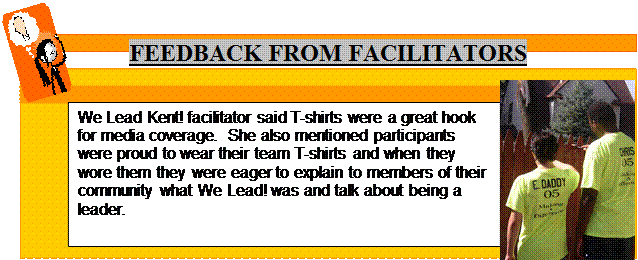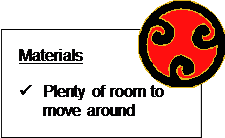
Главная страница Случайная страница
КАТЕГОРИИ:
АвтомобилиАстрономияБиологияГеографияДом и садДругие языкиДругоеИнформатикаИсторияКультураЛитератураЛогикаМатематикаМедицинаМеталлургияМеханикаОбразованиеОхрана трудаПедагогикаПолитикаПравоПсихологияРелигияРиторикаСоциологияСпортСтроительствоТехнологияТуризмФизикаФилософияФинансыХимияЧерчениеЭкологияЭкономикаЭлектроника
The Circle Connection Game
|
|

Time: 30 Minutes
Purpose: To help participants bond as a team and learn more about each other. Participants should recognize what they have in common though they are all different. Recognition of similarities will help participants to build a community.
Directions: Participants sit in an informal circle with one person in the middle. The person in the middle starts by saying, “I like to _________.” Any person that likes to do that activity links onto the first person. That person then continues the game by saying, “I like to ________.” The group continues till everyone is linked, the last person must call out something that the first person likes to do until a circle is formed.
We Lead! T-Shirt

Purpose: Making a We Lead! T-Shirt is a way to unify the participants and help to identify the group during your community service project.
Directions: It is recommended that We Lead! Participants have the opportunity to design their own ‘team’ T-shirt. By having a T-shirt the participants will be visible as they represent the We Lead! program in the community. Participants can decide as a group what their T-shirts will look like. An alternative is to ask participants which members would like to serve on a committee to design the We Lead! logo and order the T-shirts. Members of this committee can decide how they will choose the design as a team. One possibility is for members on this team to individually make logos which the whole group will vote on or members of team can design one logo together, or several the whole group could vote on. Members of this committee should then order the shirts for the group with proper size and name, if applicable.

 The Label Game
The Label Game
Time: 30 minutes
Purpose: “Label Jars, Not People” – This slogan is often used by advocacy groups. This activity explores the power a label has on how people interact with one another. This activity also will explore the stereotypes people have towards people with disabilities.
Directions: To prepare for this activity, the facilitator will need to make labels. Prepare the labels, making sure there is one label for each person in the group. Apply double-sided tape to the back of each label. If there is a large group, they should break into groups of eight or less.
Before beginning the activity, the facilitator will explain the purpose of the activity is to write an advertisement or jingle for Burger King. Right before the groups start the facilitator will explain they forgot something. Then, apply the labels randomly on the foreheads of all of the participants. It is very important that the participants do not know what their labels say.
After everyone has a label, then give the group10 minutes to attempt to come up with a jingle, interacting with each other according to their labels. They will be so busy ignoring each other, treating each other poorly and fearful of one another that they will accomplish nothing.
When time is up allow each participant a chance to guess their label before they remove it. Allow time for reflection, have participants discuss their experiences afterward.
As a large group, discuss the following questions (notes to the facilitator are in italic):
- How many of you could identify what your label was without looking at it?
- Were you focusing on the label or your task (writing the jingle)? How useful are the jingles you created?
- Ask this question to illustrate how labels, racism, ableism, and stereotyping of any kind can get in the way of all daily functions at school, on the job, at home, etc.
- If the label was your focus, why was it? Was your job unimportant?
- This will get the participants to examine why they thought the label would be the most important part of the exercise. They were instructed to come up with a jingle, yet they focused on the labels. This question will help them to examine their own biases.
- Was it frustrating or upsetting when you had something to say and people treated you badly for no apparent reason?
- Revealing how this activity made them feel personally will open the door for a conversation about understanding what other people go through on a daily basis (i.e. you are afraid of me = someone with epilepsy, I have a bad temper = someone with a mental health disability, treat me like I am stupid = someone with a learning disability, yell at me = someone who is deaf, etc.).
- Have you ever experienced any of the negative labels that some of us wore tonight? If you did, why do you think other people made you feel that way?
- There are two big reasons why people make us feel this way. The first is they do not know any better or they are ignorant. They know nothing or very little about people with disabilities and do not accept anyone who is not just like them.
- The second is because we let them make us feel bad! Respect yourself and have pride in yourself, DISABILITY PRIDE!
- A lot of non-disabled people treat us like we are stupid, ignore us, treat us like dirt, hurt our feelings, stare at us, etc. for a number of reasons. What are some of them?
- Stereotypes, fear of what is unfamiliar, etc. They should be able to give good answers to this question since this activity will be during the session on stereotypes and the movies.
- One of us wore the label, “I have a mean temper.” Why do you think we had that one?
- Many people with mental health disabilities are feared because their disability is not understood. Many people are afraid anyone with a mental health disability can and will become violent at anytime. This is obviously not true.
- What about the labels, “I always get my way, ” and, “Listen to every word I say”? Do any of you ever think that you get to do things or get away with things that your non-disabled brothers and sisters don’t?
- If you do get away with things that a non-disabled brother or sister don’t, think about why that might be. Do you use your disability to get what you want? Do not answer that now- just think about it. But remember this: for decades, disability activists have been fighting for EQUAL treatment, not SPECIAL treatment. Use your POWER wisely.
Accommodations and Skills Box

Time: 30 minutes
Source:
Purpose: A good leader can recognize both their own talent and their team member’s talent. A good leader also knows when they need help.
Directions: Staff talk directly to participants and/or guardians (if applicable) to discover unique talents or each participant. (Example: plays soccer, has given an oral presentation, knows how to wash a car, etc.)
Staff member creates a “bingo” matrix with each talent or skill in a box and makes enough copies for the group.
Participants each get a copy of the matrix and are given the directions to find out who in the room could help them with each square on the board. Participants find the person with the skill or talent listed and gets that person to initial their name in the box. The person who gets the most correct signatures wins.
After participants are finished, lead the group in a discussion about what it means to ask for help. Debrief using the following questions:
- Did you learn anything new about the members of the group?
- Can anyone in this group do something that you might have difficulty doing by yourself?
- Does every member in our group have to have every talent to be a leader?
- Does a good leader ask for help?
- What is an accommodation? How do you ask for an accommodation?